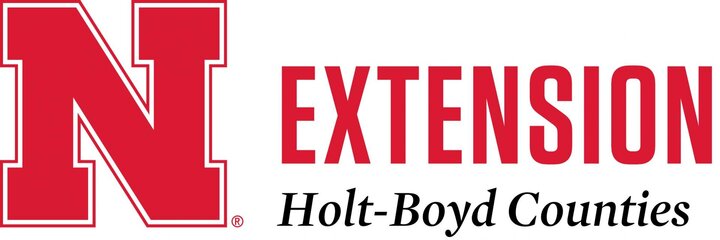
Nebraska Extension Educator - Holt/Boyd Counties - LaDonna Werth
Nebraska Extension Educator - Holt/Boyd Counties - Amy Timmerman
Nebraska Extension Educator - Brown/Rock/Keya Paha Counties - Brittany Spieker
Nebraska Extension Educator - Holt/Boyd/Garfield/Loup/Wheeler Counties - Bethany Johnston
Nebraska 4-H Assistant - Holt/Boyd Counties - Debra Walnofer
March 27: Face-to-Face Private Pesticide Training, 1:30pm, Our Savior’s Lutheran Church, Spencer, NE, pested.unl.edu
March 27: Face-to-Face Private Pesticide Training, 1pm-4pm, Walter Larsen Senior Center, Creighton, NE, pested.unl.edu
March 27: Face-to-Face Private Pesticide Training, 6pm-9pm, Walter Larsen Senior Center, Creighton, NE, pested.unl.edu
April 1: DUE: Holt County 4-H and FFA Market Beef and 2nd Year Bucket Calf ID Sheets, Holt County Extension Office, O’Neill, NE
April 2: DUE: Nebraska 4-H Shooting Sports Initial Instructor and Instructor Update, Bassett - Early Bird registration deadline is April 2, 4 pm CT. Registration fee goes up after 4pm CT on April 2 and registration will close on Friday, April 4, 2025, 4 pm CT. https://events.unl.edu/NE4H-Shooting-Sports/
April 8: Face-to-Face Initial Commercial/Noncommercial Pesticide Training, 8:30am-5pm, Holt County Annex, O’Neill, NE, pested.unl.edu
April 9: Private Pesticide Training, 1:30pm, Holt County Annex, O’Neill, NE, pested.unl.edu
April 10: Private Pesticide Training, 9:30am, Lutheran Church, Ainsworth, NE, pested.unl.edu
April 10: Chemigation Training, 1:30am, Lutheran Church, Ainsworth, NE, pested.unl.edu
April 10: Nitrogen Certification Training, 1:30pm, Lutheran Church, Ainsworth, NE, pested.unl.edu
April 11: Chemigation Training, 9:30am, Holt County Annex, O’Neill, NE
April 12-13: Nebraska 4-H Shooting Sports Instructor Initial Workshop, 8:30am-6pm, Bassett Community Building, Bassett, NE
April 12-13: Nebraska 4-H Shooting Sports Instructor Update Workshop, 8:30am-12pm, Bassett Community Building, Bassett, NE
April 12: 4-H Shooting Sports Leader Update Workshop, Bassett, Early bird registration (lower price in training) is April 2 https://events.unl.edu/NE4H-Shooting-Sports/
April 16-17: Nebraska State 4-H BB Gun and Air Rifle Championships, Christensen Field 1914 Christensen Field Rd, Fremont, NE, https://events.unl.edu/NE4H-Shooting-Sports/2025/03/15/
April 26-27: 4-H Shooting Sports Leader Certification Workshop, Hastings, Early bird registration (lower price in training) is April 16 https://events.unl.edu/NE4H-Shooting-Sports/ (Early Bird registration deadline is April 16, 4 pm CT. Registration fee goes up after 4pm CT on April 16 and registration will close on Friday, April 18, 4 pm CT.)
April 26: 4-H Shooting Sports Leader Update Workshop, Hastings, Early bird registration (lower price in training) is April 16 https://events.unl.edu/NE4H-Shooting-Sports/ (Early Bird registration deadline is April 16, 4 pm CT. Registration fee goes up after 4pm CT on April 16 and registration will close on Friday, April 18, 4 pm CT.)
April 29: Face-to-Face YQCA Training, 7pm, Holt County Courthouse Annex,
Families Should Set Guidelines to Ensure Quality Studying
Every family needs to set their own guidelines for studying at home, according to Renette Wardlow, human development specialist, University of Missouri Extension.
“Differences in guidelines occur because of the different ages of students,” said Wardlow.
For example, younger children have less homework, but it generally requires more parent supervision. As children grow older, developing the skill of independently tackling homework without parent help becomes important.
“Children of all ages need a good place to study and a specific time to study, with minimal distractions,” said Wardlow.
Developing the proper frame of mind for studying will help reduce distractions and bring about positive results.
It is also essential to plan ahead, organize studying around a regular schedule and get materials organized. This is important in order to find what is needed when you need it, to get assignments done on time and to avoid procrastination. There are several ways to get focused and organized ahead of time.
For example, Wardlow advises that children need to plan ahead and get a good night sleep the night before they’ll have to do a lot of studying.
LaDonna Werth
Extension Educator
Phone: 402-336-2760
E-mail: LWerth2@unl.edu

Wardlow also recommends that children focus on their strong points. Instruct your child to “think about the things you do best in school and develop a positive self-image,” said Wardlow.
It is important for each child to study in a comfortable place that has good lighting in order to avoid eye strain and fatigue. Wardlow recommends avoiding distracting music during study times.
“It is true that some people study well with background music, and for different people different kinds of music will suit,” said Wardlow.
It is also a good idea to not watch the clock or count the pages left while trying to study, according to Wardlow. Getting together with friends to study can also be very distracting, especially when everyone is not studying the same topic.
Source: Renette Wardlow, human development specialist, Christian County, University of Missouri Extension, wardlowr@missouri.edu
Grain Safety: Essential Tips to Prevent Accidents and Protect Lives
Grain safety refers to the practices and precautions taken to ensure the safe handling, storage and transportation of grain to prevent hazards such as grain entrapment, dust explosions, spoilage and contamination. It is crucial for workers in the agriculture and grain industry to follow proper safety protocols to avoid accidents and health risks.
With Grain Safety Week (March 24-28, 2025), it’s a reminder of the critical steps for how to stay safe around grain.
The following are different aspects of grain safety with steps to avoid hazards:
1. Grain Bin Safety
- Avoid entering grain bins when grain is flowing to prevent entrapment and suffocation. An article from the Great Plains Center for Agricultural Health shows how entrapment happens, explains how to prevent it, and provides information on how to create a lifeline.
- Use a harness and lifeline when entry is necessary.
- Have an observer present when entering bins.
Amy Timmerman
Extension Educator
Phone: 402-336-2760
E-mail: atimmerman2@unl.edu

2. Dust Explosion Prevention
- Control grain dust levels through proper ventilation and housekeeping.
- Use explosion-proof electrical equipment in grain storage facilities.
- Prevent ignition sources, such as open flames or sparks, near grain storage areas.
3. Proper Storage and Handling
- Maintain correct moisture levels to prevent spoilage and mold growth.
- Use proper aeration and drying techniques to keep grain in good condition.
- Regularly inspect grain bins and silos for structural integrity.
4. Equipment Safety
- Lockout/tagout (LOTO) procedures should be followed before servicing machinery.
- Avoid loose clothing near augers, conveyors and elevators to prevent entanglement.
- Train workers on the safe use of grain handling equipment.
5. Health Considerations
- Wear respiratory protection when working in dusty environments. Read how to properly fit a respiratory mask at https://cropwatch.unl.edu/2016/protect-your-lungs-properly-fitted-respiratory-masks/.
- Be aware of toxic gases (e.g., carbon dioxide, fumigants) in confined spaces.
- Watch for signs of heat stress when working in hot conditions.
Following proper grain safety measures can significantly reduce the risk of accidents, injuries and fatalities in the grain handling industry. By prioritizing grain safety, workers stay protected, businesses run smoothly, and grain products remain high-quality.
Resources:
- Nominate Your Fire Department — Nationwide Insurance and the National Education Center for Agricultural Safety each year host a program that awards grain rescue tubes and hands-on training in using the tubes. Here's how to nominate a community.
- Preparing Grain Bins for Harvest talks about how to prepare them and treat/fumigate if necessary.
- Central States Center for Agricultural Safety and Health at the University of Nebraska Medical Center, provides research and information for farmers. Health projects engage producers throughout the seven-state region.
- Avoid Risks When Working Around Grain Handling and Processing Equipment
- Fast Facts on grain safety from the Grain Handling Safety Coalition.
- U.S. Agricultural Safety and Health Centers provides videos to watch showing what can happen with entrapment.
- Grain Handling Safety Coalition. Videos and downloadable courses on a number of aspects of stored grain safety, from reducing grain bin entry risks to the installation of a lifeline.
- Entrapment Risks Due to Flowing Grain
- Grain Storage Safety
- Caught in the Grain! talks about the hazards of flowing grain and how to prevent a grain entrapment situation.
Source: Nicole Luhr - UNL Extension Educator (CropWatch - March 20, 2025 - https://cropwatch.unl.edu/grain-safety-essential-tips-prevent-accidents-and-protect-lives/)
Protecting Farms & Ranches from Wildfires
Wildfires affect America’s farm and ranches, damaging and destroying homes, barns, agriculture production facilities, crops, and livestock. Below are some tips to help avoid or minimize fire damage to your property.
Measures include:
- Install and maintain smoke detectors. Smoke detectors should be installed in barns and buildings and checked at least once per month. Batteries should be changed at least once per year.
- Develop an escape or evacuation plan and practice it. The evacuation plan should also include how to transport animals and livestock that may be in danger.
- Post emergency numbers in a central location, including the fire department, police department, local emergency response coordinator, and others who provide emergency assistance.
- Place fire extinguishers in all barns, vehicles, and tractors. Check extinguishers periodically for charge. Discard damaged or used fire extinguishers.
- Store fuels, pesticides, medicines and other chemicals in a fire-retardant enclosure or secure location away from heat sources and combustible materials. In the event of a wildfire, these substances should be removed from the premises.
- Keep barns and buildings clean of trash and other combustible materials such as hay, lumber, logs, and empty feed sacks.
Bethany Johnston
Extension Educator
Phone: 402-336-2760
E-mail: bjohnston3@unl.edu

Practice Farm and Ranch Specific Fire Safety
- Make sure your farm/ranch has adequate water supply, such as an irrigation ditch, a water tank, a cistern, or a pond.
a. Keep stock tanks full when weather allows by turning on solar wells, windmills and pipeline fed tanks. This will help your local fire department have a water source in case of a fire. - When it is dry be careful when driving atvs, vehicles, tractors, and bale feeders in dead, tall standing grass. Any kind of spark or heat source may ignite the dry grass on fire.
- Keep irrigation sources free of combustible material.
a. It may warrant running the irrigation well to wet things down especially if a fire is headed your way. - Keep farmstead areas clear of weeds, grass, and other debris. Keep areas near buildings mowed and trees pruned 6 to 10 ft above the ground and fuels away from buildings that could create a path for fire into the eave/soffit.
- Make sure dead trees are removed especially if they are near electrical lines.
- Park tractors and implements away from combustible materials such as hay bales, haystacks, and fuel storage containers.
a. Have tractors hooked up to discs so you can use this equipment to make a fire break for an approaching fire.
b. Fill liquid tanks when not in use with water for fire suppression. - Obtain fire insurance for livestock, buildings, and equipment.
- Conduct random, but regular inspections and fire drills. Invite the fire department for these drills to minimize confusion during an actual occurrence.
- Keep above ground fuel storage at least 40 feet from buildings.
During a Fire
If a wildfire threatens your farm or ranch, always remember that human life must be first priority, property comes second. Keep in mind, however, that when firefighters arrive, they may ask which to save first, second, third, etc., so determine beforehand the order of importance: livestock, machinery, or feed.
If you become trapped in a burning barn or building, practice fire safety:
- Get out quickly, but safely.
- Stay low since smoke rises and cover your mouth with a clean cloth to avoid inhaling hot smoke and gases.
- Close doors after escaping rooms to slow the spread of fire.
- If smoke is pouring in the room at the bottom of the door, and the door feels hot, keep it closed.
- Open a window to escape or for fresh air while waiting to be rescued.
- If no smoke is coming under the door and it is not hot, open it slowly to escape.
If you have time to evacuate animals, proceed with caution. Some animals may refuse to leave, and some may even run back into a burning barn or building. Make sure to close gates prohibiting access to dangerous areas. When evacuating animals, do not lead them to where they will become trapped or to a dead end.
The aftermath of a wildfire can be hazardous. A few precautions must be taken after a wildfire takes place on your property:
- Stay out of damaged barns and buildings and return to your property only when authorities permit you to do so.
- Notify proper authorities if you believe that hazardous materials were released in the fire or during firefighting. Place warning signs on contaminated areas.
- When disposing of some materials, such as those potentially contaminated with chemicals, check on state and local requirements for disposal procedures.
- Consult someone from the local Emergency Planning Committee or the State Division of Emergency for legal clean-up procedures if needed.
- Keep livestock away from contaminated feed or water.
- Wear protective gear when entering contaminated areas and damaged barns and buildings. Protective gear includes steel-toed boots, hard hat, respiratory protection, gloves and other protective clothing.
- Before entering a barn or building assess the true integrity of the structure. Always turn off the electrical power and other utilities to the structure until a thorough inspection by a fire marshal or a legal authority clears it to be entered.
- If the decision is made to demolish a building, hire a professional. Professionals will be able to do the job more efficiently and safely.
- Check with your insurance provider so you know ahead of time what is covered by wildfires. Take pictures of all damage, and inventory all damaged structures, supplies, equipment, and machinery. Save receipts for expenses relating to the fire.
- Contact the local Farm Service Agency on possible disaster programs that might help you recover.
Animals are especially susceptible to wildfires, particularly those that are confined to small pastures. After a wildfire, examine all animals exposed to wildfire smoke, heat or burns. You may need to spray animals with water to cool them down. You may need to humanely euthanize some animals due to the extent of their injuries and follow state guidelines for proper disposal.
Just as you care for your farm and livestock, be sure to take care of yourself, family, and your neighbors during this time. Resources are available:
- Nebraska Rural Response Hotline: 1-800-464-0258
- National Suicide Prevention Lifeline: 1-800-273-8255 or text 741741
- UNL Rural Wellness on the web – https://ruralwellness.unl.edu
Source: Randy Saner - Nebraska Extension Educator; Rob Eirich - Nebraska Extension Educator; Ryan Benjamin - Nebraska Extension Educator (BeefWatch – March 17, 2025)
News Release
4-H Shooting Sports Instructor Workshops
Do you enjoy hunting? Do you have an interest in helping the youth of our county get involved in hunting and archery? Adult volunteers help to teach youth marksmanship, the safe and responsible use of firearms, and the principles of hunting and archery.
The Holt and Boyd 4-H Shooting Sports programs are looking for more adult volunteers. The 2-day Leader Certification Workshop Training is being offered in Bassett on April 12-13. You can get certified in one of the following disciplines: rifle (includes BB, air, & .22), pistol (air &.22), archery, shotgun, and coordinator.
If April12-13 isn’t open on your calendar, maybe the April 26-27 training at Hastings is. At this training you can get certified in rifle (includes BB, air, & .22), pistol (air &.22), archery, shotgun, muzzleloading, coordinator, and ambassador.
Participants at the training will spend time both in the classroom and at their respective range during the workshop. Volunteers do not need to have a family member enrolled in 4-H to serve as a 4-H volunteer.
Are you ready to help youth with skills that they can enjoy for the rest of their life. Register today at https://events.unl.edu/NE4H-Shooting-Sports/
April 12-13 Bassett - Leader Certification Workshop early bird registration (lower price in training) is April 2.
April 26-26 Hastings - Leader Certification Workshop early bird registration (lower price in training) is April 16.
Boyd County 4-H Council will reimburse you for completing the training and if you enroll in 4-H as a Boyd County 4-H Shooting Sports Volunteer.
Current Certified Leader and Apprentice Leaders - UPDATE
Leader updates are offered throughout the year. These are intended only for adult or apprentice 4-H volunteers who have previously attended a Leader Certification Workshop. These are an update training for existing certified leaders only, not for new or prospective leaders. Attendees must be currently enrolled Nebraska 4-H Shooting Sports volunteer leaders in their county and in good standing.
April 12: Bassett - Leader Update Workshop, Early bird registration (lower price in training) is April 2.
April 26: Hastings - Leader Update Workshop, Hastings, Early bird registration (lower price in training) is April 16.
Nebraska Extension Addressing Drought Prep for Cattle Producers April 15
On going drought conditions will require delayed turnout on pasture, reduced stocking rates or alternative sources of feed for cattle this summer. To provide producers with information on options for managing and mitigating the impacts of drought, Nebraska Extension will offer an evening webinar program with the option to attend host site locations on Tuesday, April 15 from 6:30 to 8:00 pm Mountain Time / 7:30 to 9:00 pm Central Time.
Drought Preparation Program Topics include:
- Conditions and Outlook – Dr. Eric Hunt, Nebraska Extension Agricultural Meteorologist,
- Rangeland Response to Drought – Dr. Mitch Stephenson, Range Management Specialist,
- Annual Forage Options – Dr. Jerry Volesky, Range & Forage Specialist,
- Summer Dry Lot Feeding Pairs – Dr. Karla Wilke, Cow-Calf Management Specialist,
- Programs for Producers – Laura Baker, CED Kimball County Farm Service Agency.
The program will focus on delivering key information for producers to consider, with time for questions from those in attendance.
There is no cost to attend the program, but local host sites would appreciate pre-registration to plan for the number of those attending.
- Kimball – Aaron Berger, Kimball-Banner Extension Office, 209 East Third, 308-235-3122;
- O’Neill – Bethany Johnston, Holt County Annex Building, 128 N 6th St., 402-336-2760.
- Rushville – Brock Ortner, Sheridan Office, 800 South Loofborrow St., 308-327-2312;
- Scottsbluff – Dr. Mitch Stephenson, PREC Bluestem Room, 4502 Ave I, 308-632-1355;
- Thedford – T.L. Meyer, Upper Loup NRD Meeting Room, 39252 NE Hwy 2, 308-645-2267;
For those planning to attend remotely, please contact Aaron Berger, aberger2@unl.edu, to register and receive Zoom connection information.
Questions about the program? Contact Aaron Berger at 308-235-3122.
Not able to attend the live session? The program will be recorded and archived for those not able to attend in person or online.